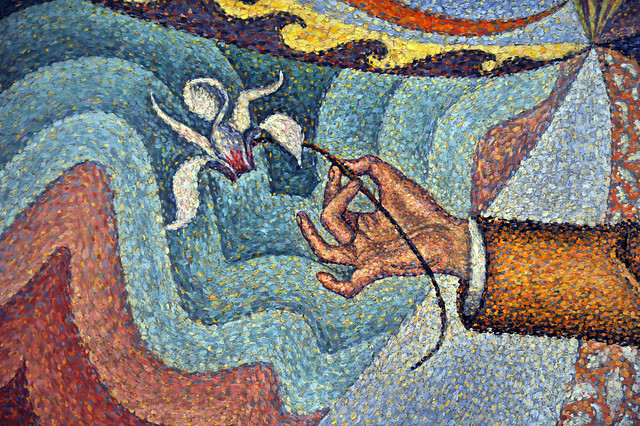Like most artists in the avant-garde of post-Impressionism, Gauguin felt disillusionment with the results of the Industrial Revolution: spreading pollution and changing socioeconomic hierarchies, the most notable being women rising into the labor force from traditional roles. From this disillusionment was born Gauguin's idea of primitivism: that non-industrialized societies are purer than what most of Europe was going through. Gauguin eventually became separated from his family after losing his job, and traveled literally around the world to find some civilization that was untouched by the ever-spreading influence of European imperialism, which was colonizing large portions of the world.
After spending some time in Panama, Gauguin eventually settled down in Tahiti, an island located in the South Pacific. Even in this remote location, European influences were still present in the population and their attire. Nevertheless, Gauguin settled down and started a new life, marrying for a second time. Unfortunately, their first attempt at a child resulted in a stillbirth. It was at this time that Gauguin painted his last iconic work, Where Do We Come From? What are We? Where are We Going? This work was a representation of his anguished mind: his inability to escape industrialization, and his inability to start properly at least a semblance of an escape from European imperialism.
The work is a summary of all of Gauguin's experiences in the South Pacific: a collection of Tahitian people at perfect ease in each other's presence, with no signs of European imperialism in view. In the background stands a statue of a Tahitian deity, whole with no imperfections. Gauguin described this work as part of "a mysterious language of the dream." It represents his ideal view of a pure, untouched culture that is at peace with itself. However, when this image is placed alongside its title, the mood generated is completely conflicted: if this is an idealized view of a perfect culture, then why does it have such a cynical title?
This work was not the only one that Gauguin produced in Tahiti. Another notable work that he produced was Oviri, the last of his ceramic works.
The statue consists of a bare-chested woman who is sitting on top of a dead wolf and strangling a wolf cub in her left hand. Her emotionless face suggests that this is not the first, nor the last time that she will do this. Oviri means "savage" in Tahitian, and Gauguin described her as "a cruel enigma" and a "murderess." Given that Gauguin moved to Tahiti to escape the industrialization of Europe, it is possible that the wolves represent Gauguin's hopes of starting completely fresh in Tahiti, and the woman the cruelty of industrialization and European imperialism.
Ultimately, after spending roughly ten years in the South Pacific, Gauguin moved to the island of Hiva-Oa in the Marquesas Islands, where he died in 1903. His idea of primitivism, however, would live on in the works of artists like Henri Matisse and Pablo Picasso, who went to the Americas and experienced their own share of indigenous cultures.
Les Demoiselles d'Avignon, by Pablo Picasso.







-large.jpg)






-1890-small.jpg)













